Optimizing your email data strategy
Published on November 06, 2025/Last edited on November 06, 2025/11 min read
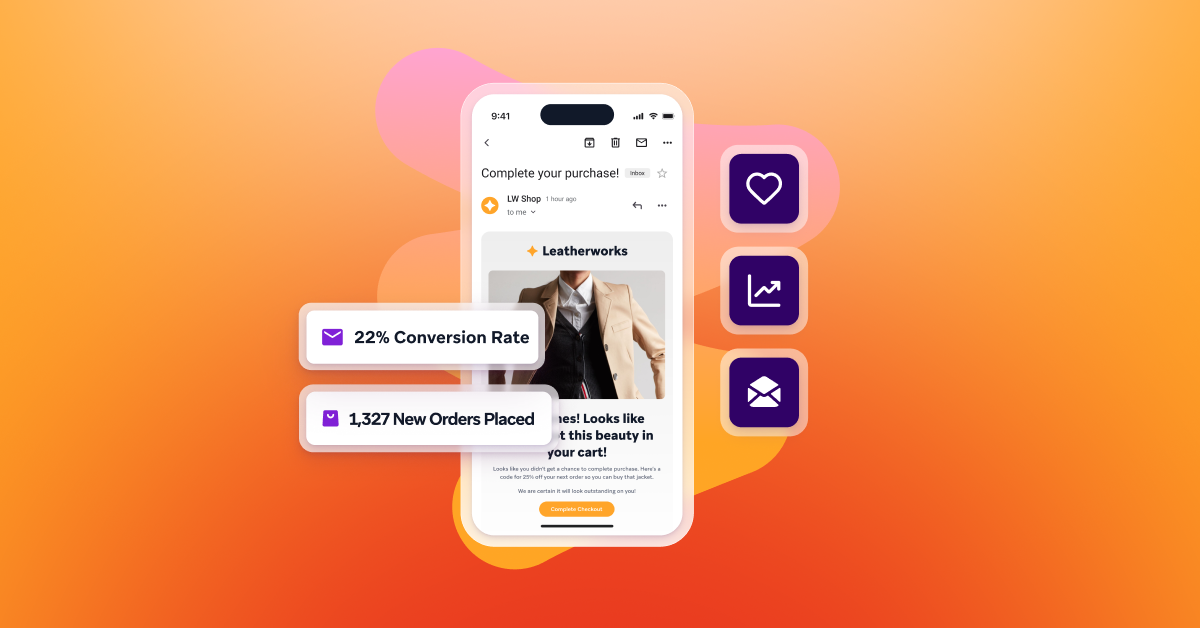

Team Braze
No email marketing strategy is complete without an email data strategy. An effective email data strategy helps marketers use their customer data to better segment, target, trigger, and personalize their emails—driving overall email marketing performance.
Looking for guidance on what a clearly defined email data strategy should look like and how to build one to support your email marketing program? We’ve got a framework you can follow from our recent webinar “Getting your Email Data Strategy Right.”
In this webinar, our presenters—Kevin Shectman, Senior Director, Product Marketing at Braze, and Chris Marriott, President and Founder at Email Connect, a boutique consultancy firm that helps enterprise Fortune 500 brands select and upgrade their email service providers—walked through the steps marketers should take to define and refine their email data strategies. They also explained the role email marketing platforms play in shaping email data strategies and shared examples of what happens when brands get their email data strategies right and what happens when they get them wrong. Let’s dive into these highlights now.
Why data is essential to your email marketing program
Back in 2010, the then head of Google, Eric Schmidt, calculated that a staggering five exabytes of information had been created between the dawn of civilization up until 2003. By 2010, that amount of information was being generated every two days. Fast-forward to today, and experts say we’re on track to produce more than 463 exabytes of data every day.
Consumers are generating more data than ever before, but brands aren’t catching up. Many fail to understand what their customers want and need in the moment. That’s because many marketers lack access to the right insights, so they’re not able to act on them in a timely manner, and they’re not able fully take advantage of data they do have.
Issues with data—including insufficient data, data silos, and poor data quality—are preventing marketing teams from delivering more meaningful, relevant, and valuable experiences that foster customer engagement and increase customer lifetime value.
And research on the value of data-driven email marketing speaks for itself:
- 52% of consumers say they’ll look somewhere else if an email isn’t personalized
- Personalized emails get opened 82% more often than generic emails
- Segmenting campaigns can boost revenue by up to 760%
“The better you’re able to segment and curate a one-to-one email experience to the particular subscriber, the better you’re going to impact your top-line performance,” says Kevin Shectman, Senior Director, Product Marketing at Braze.
How email marketers can define their data strategy
Based on our experience working with brands across verticals and business models, our experts at Braze have developed a four-step process that can help you build, define, and refine your email data strategy—no matter where you’re at with your current data journey. In our webinar, Shectman walked marketers through what’s involved in these four steps.
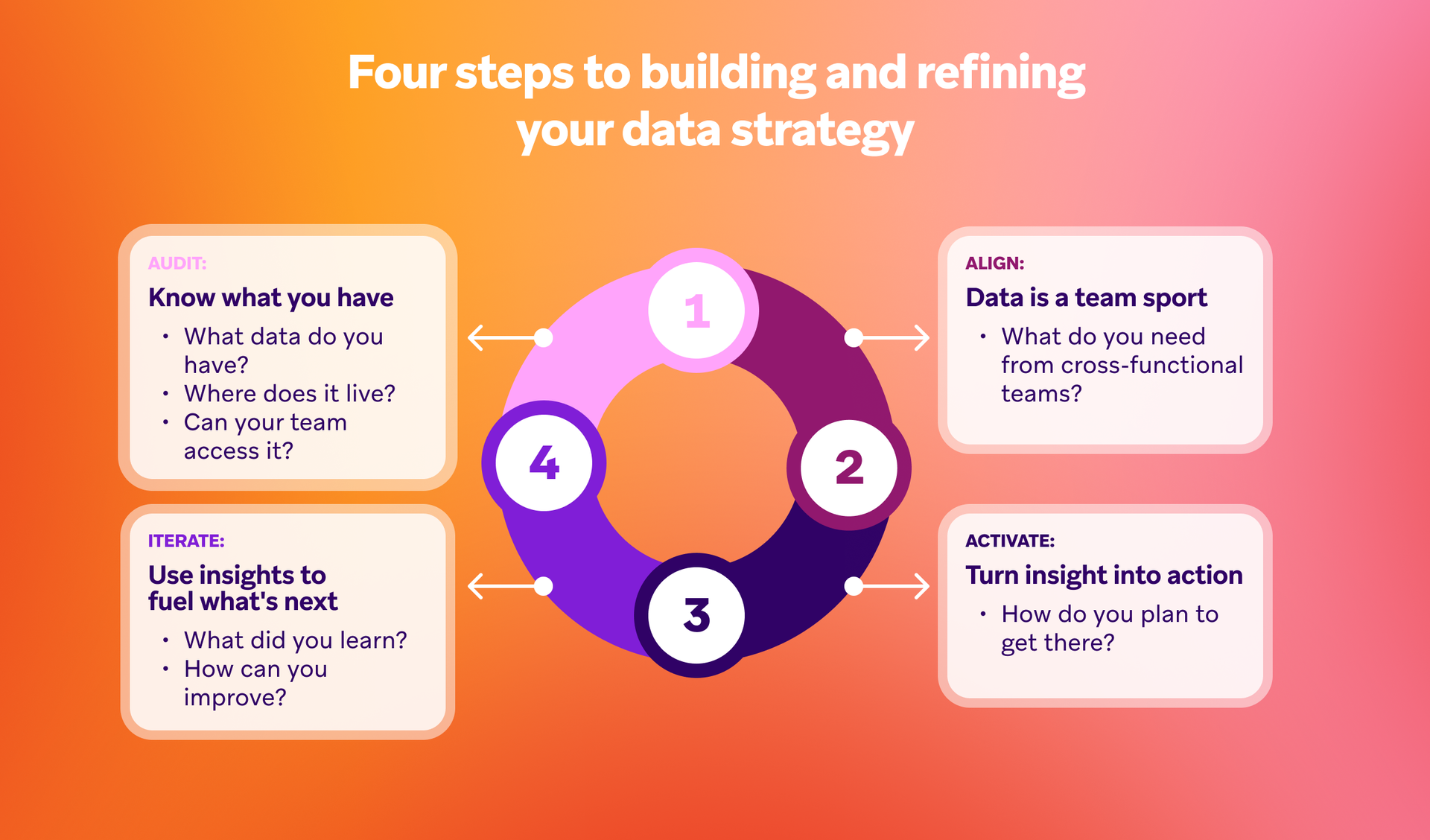
Step 1: Audit your current data
First, start with conducting an audit of your existing data sets and tools and defining your top line business objectives and engagement goals.
“This is the foundation of an effective data and customer engagement strategy,” explains Shectman. “It hinges upon knowing what you’re trying to accomplish in the first place and what you’re working with. Nothing matters more than having a clear understanding of what you’re trying to achieve.”
Questions to ask:
- What am I trying to do or understand?
- Where is my data today?
- What technology is in place?
- What data do I still need to achieve my goals?
Step 2: Get cross-functional alignment
The next step is to get alignment from key stakeholders across functions and work together to create a joint strategy and tech stack. To do this, you can use a shared visualization tool to outline everything in a shared workspace.
“This is really imperative for connecting the dots across your business, getting teams talking to one another, and setting you, of course, and your customers up for success,” says Shectman.
Questions to ask:
- Who is responsible for these data sources?
- What are our shared goals and metrics?
- What do our ideal tech stack and data flow look like?
Steps 3 and 4: Operationalize your data and use what you learn to fuel continuous improvement
At this stage, you’ll start leveraging your data to orchestrate a more tailored customer journey to reach the right audiences using segmentation and generate much more personalized experiences on a one-to-one basis—but this shouldn’t be a one-off step. This needs to become an ongoing process to keep improving the customer experience.
Exploring the role of the tech stack in executing your email data strategy
For email marketers, selecting the right email service provider (ESP) is one of the most important MarTech investments you can make to enable your strategy.
Over the last nine years, Chris Marriott, President and Founder at Email Connect, and his team have conducted massive deep dives into the features and functionalities of ESPs to find the best fit for their clients. In our webinar, he explained the advantages and disadvantages of the two main types of email service providers available today—legacy marketing clouds (built using relational databases) or next-generation email marketing platforms (built using NoSQL databases)—and the key features, considerations, and advantages and disadvantages of each.
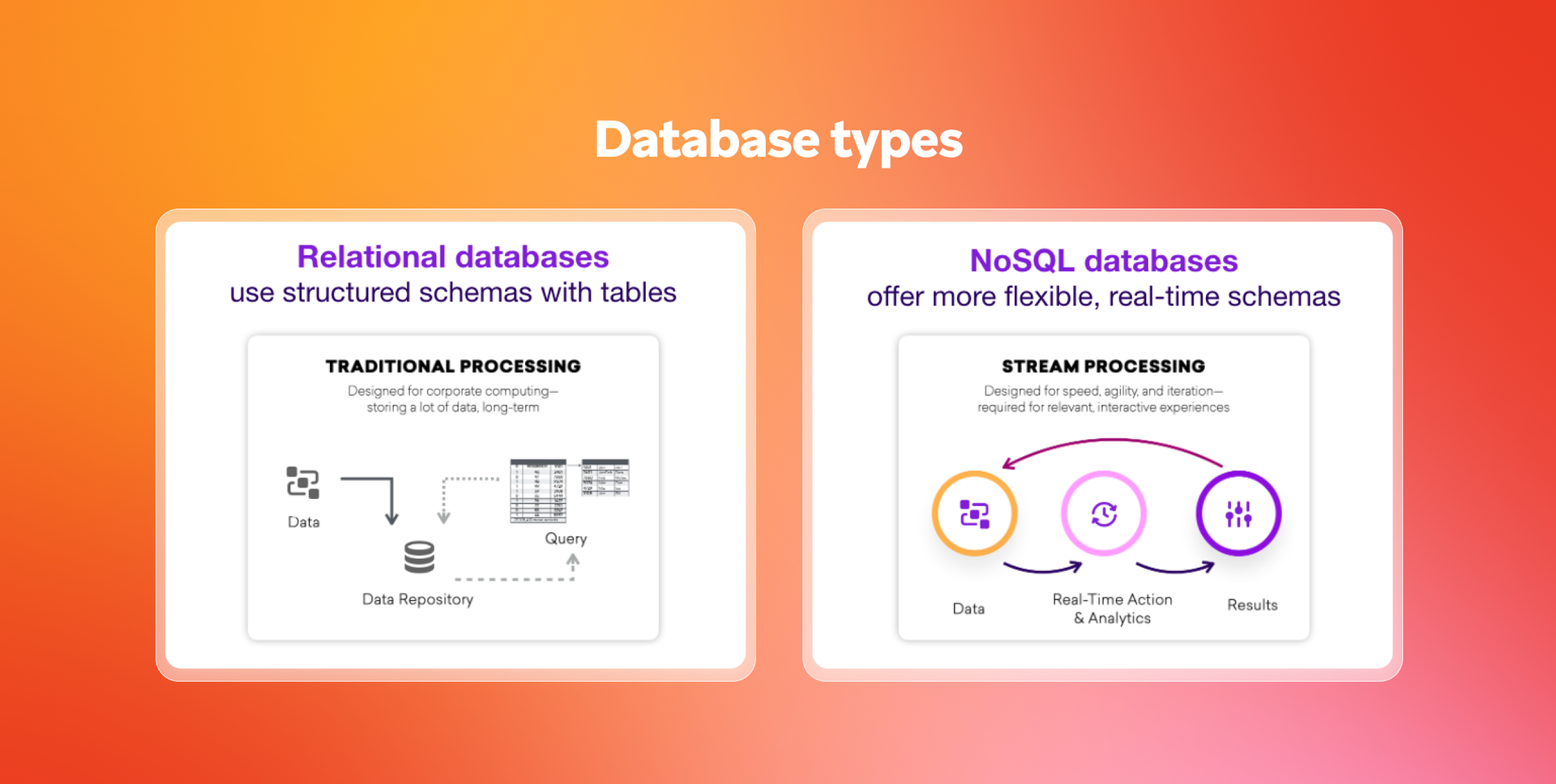
Legacy marketing clouds
These are relationship databases built on static subscriber lists using structured schemas with tables. These systems are ideal for campaigns based on well-defined relationships between data points, such as sending an email to specific customers about specific transactions, but they can involve reworking schema and migrating data—which takes time that isn’t necessary when working with NoSQL databases.
“What we’re seeing is legacy marketing clouds are being considered less and less. A lot of brands don’t want to look at them and for good reason. In many cases, innovation has stalled. It’s not just a perception, but it’s a reality,” says Marriott. “Brands want to see what new options are out there and if those can better meet their needs.”
Advantages of relational databases
List-based, relational databases are highly structured, offer consistent reporting and segmentation, and are easy to use for simple queries (such as sending a campaign to all of the subscribers who live in a certain location).
Disadvantages of relational databases
They’re not as scalable as subscriber bases grow (this requires more server resources) and they’re not as flexible. Your schema will need to be updated when you’re adding new fields, such as for personalized content, which can be time consuming and cumbersome.
Next-generation email marketing platforms
These are built on NoSQL databases backed by stream processing.
Next-generation, NoSQL database platforms are becoming the go-to choice for marketers—they are more flexible, power real-time action and analytics, and can be tailored to your brand’s particular needs, explains Marriott.
They can handle structured, semi-structured, and unstructured data and they can also scale to support fast-growing businesses and surges during holidays.
Advantages of next-generation email marketing platforms
Email marketing platforms powered by streaming data enable high-speed personalization at scale, flexibility for adding new data fields for dynamic personalization, and enable real time insights.
Disadvantages of next-generation email marketing platforms
Some challenges may include needing more tools or expertise to query your data effectively or dealing with inconsistent segmentation as a result of data that hasn’t always been strictly managed and structured consistently.
How a NoSQL Database can support your email data strategy
Each database choice (relational vs NoSQL) has its pros and cons, and it’s important to understand their differences when it comes to how they structure data, their schema options, their data flexibility, their scalability, their performance, and how they activate data.
Braze utilizes a NoSQL database structure, which is designed to handle large volumes of unstructured and semi-structured data. This flexibility allows Braze to efficiently store and manage diverse data types, such as user profiles, event data, and engagement metrics, without the rigid schema constraints of traditional relational databases.
For email marketers, this NoSQL approach offers several key benefits. Firstly, it enables real-time data processing, allowing marketers to access and analyze user behavior without delay. This capability is crucial for crafting real-time and personalized email campaigns that resonate with individual users based on their recent interactions.
Secondly, the scalability of NoSQL databases means that as a brand's user base grows, it can seamlessly accommodate increased data loads without compromising performance. This enables marketers to continuously leverage comprehensive data insights for segmentation and targeting.
Additionally, the ability to integrate various data sources enhances the richness of user profiles, enabling more sophisticated audience segmentation and tailored messaging. Overall, a NoSQL structure empowers email marketers to execute data-driven strategies that enhance customer engagement and drive conversions, ultimately leading to more effective marketing outcomes.
As you evaluate your current ESP or potential ESPs, here are key questions to ask yourself to help choose the right platform:
- What integration(s) are used to get data to your ESP? How does the platform ingest, store, and activate zero- and first-party data to support customer engagement?
- How does this solution support connections to third-party systems to ingest customer and behavioral data (e.g. user preferences, transaction data, historical user action data)?
- How does the solution work with other key technologies (e.g. product analytics, recommendation engines, CDPs, BI tools)?
- When changes occur with customer data, how quickly does the solution make that updated information available for segmentation, personalization, and customer journey orchestration?
- Does the platform have the ability to automatically and immediately direct a given user through a customer journey when a relevant new event or action occurs?
- What sorts of criteria can brands use to trigger campaigns and orchestrate customer journeys within the solution?
- How has the solution been designed to handle high-volume/demands for major campaigns and seasonal engagement peaks (e.g. Black Friday, Singles Day)?
- How easy is it to modify or enhance the data design within the application post implementation? Can this be accomplished without vendor assistance or professional services?
When data-driven email goes right (and wrong)
Well designed, brilliant email campaigns are data-driven and personalized, provide valuable relevant content for recipients, drive users to click and convert, and offer the chance to build brand equity and loyalty.
Broken emails have the opposite effect: They aren’t tailored and can actually break your brand loyalty and equity by disrupting the experience customers want to have with your brand.
Broken email example #1: A subscription service mistakenly re-engages a past customer by encouraging them to check out a completely irrelevant product
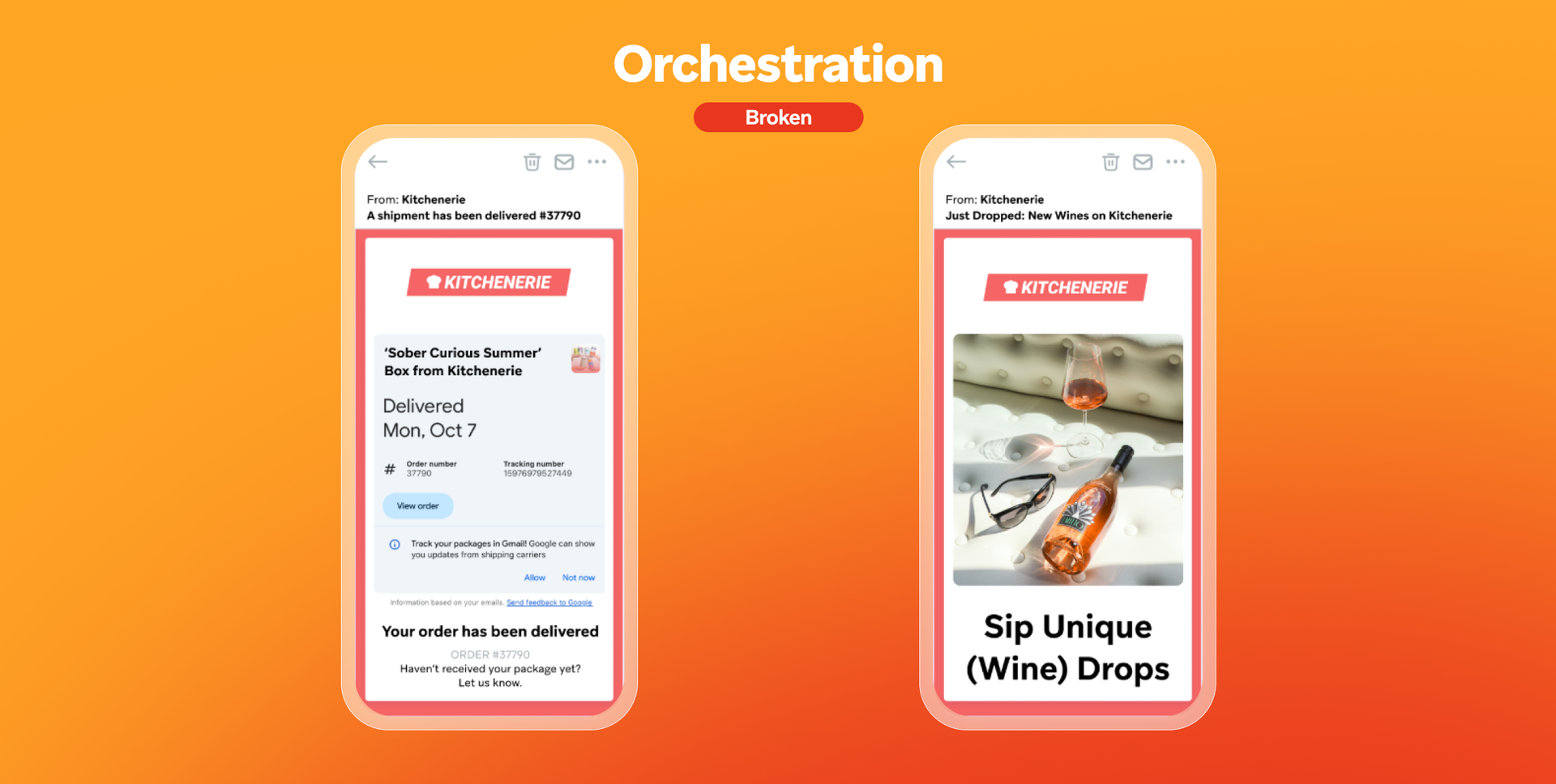
As illustrated in these imagined campaigns above, a customer purchases a non-alcoholic sampler, a sober-curious product offering from the fictitious brand Kitchenerie. As a follow-up, the brand sends a marketing campaign showcasing the company’s wine selection. This disconnected experience ignores the customer’s observed browsing behavior and confirmed purchase, a data orchestration fail.
Brilliant email example #1: A fashion brand recognizes a customer has been hesitating to complete a purchase and sends a reminder with a promo code
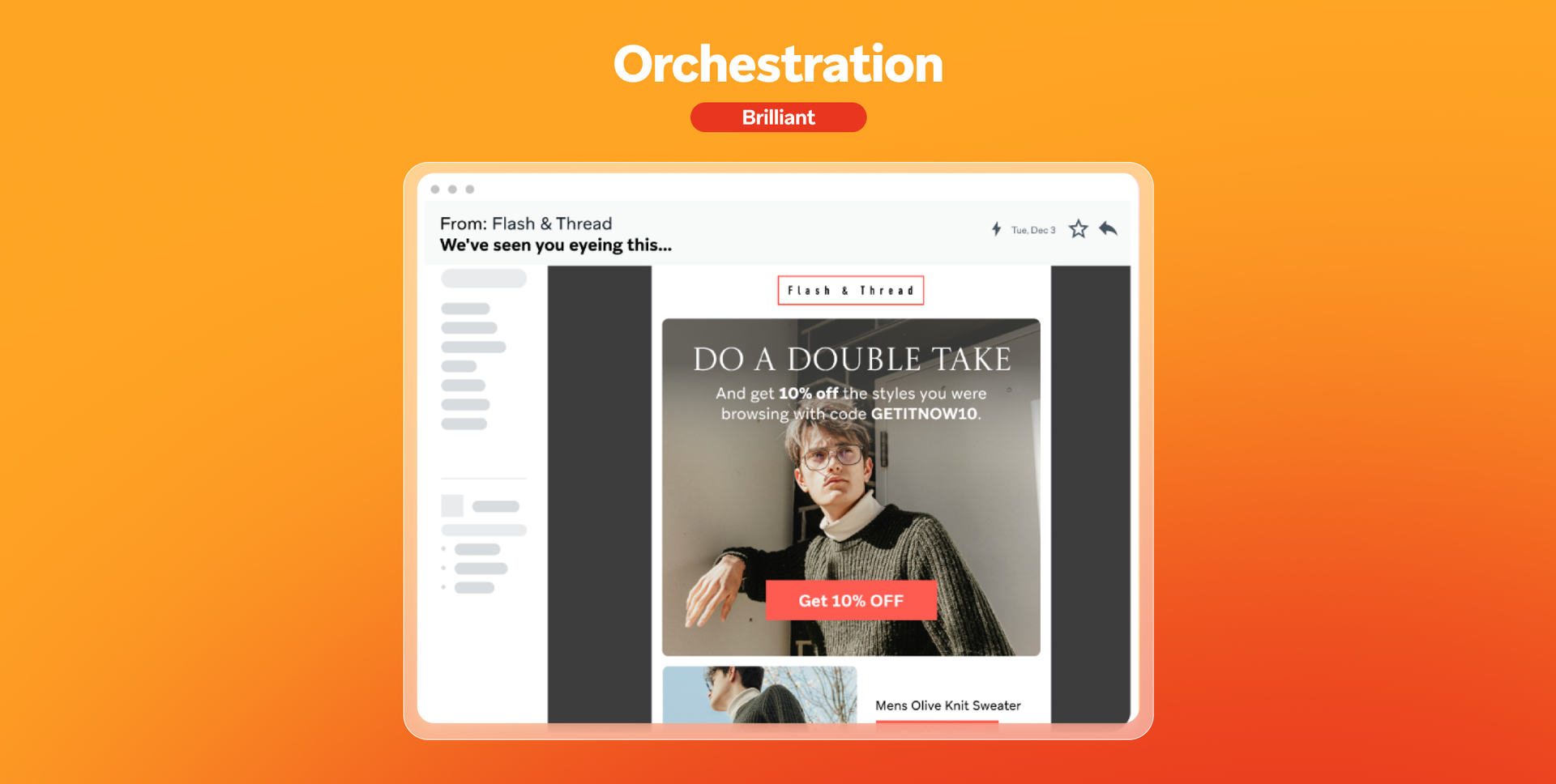
In contrast with the broken example above, in this sample campaign, the fictitious retailer Flash & Thread observes a customer’s browsing behavior and responds with a timely tailored email.
Broken email example #2: A financial services brand sends an important email late
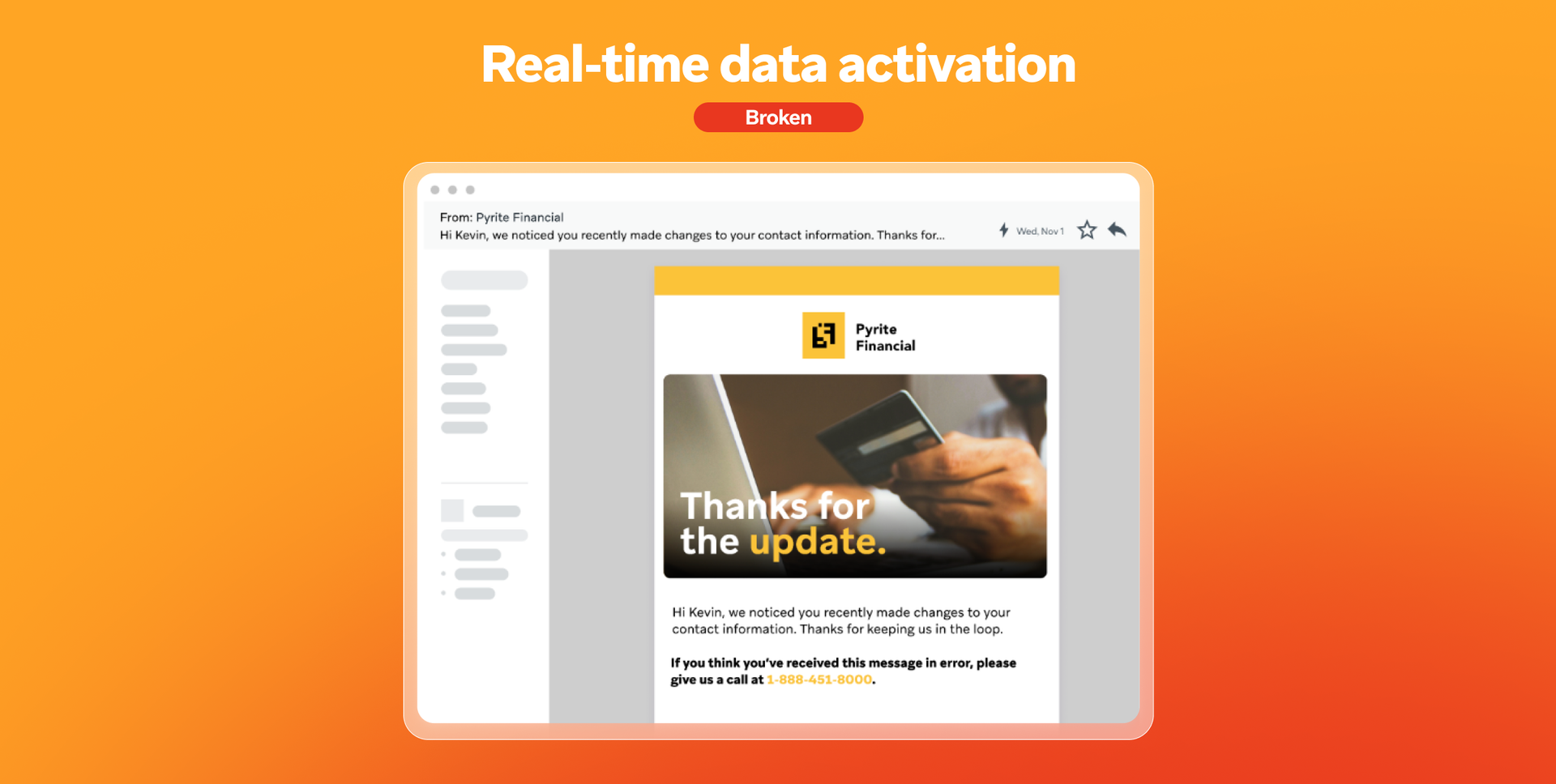
Instead of sending a real-time confirmation email right after a customer makes a change to their account, the fake brand Pyrite Financial creates a confusing experience by only acknowledging a change has been made three days later. With such a delayed confirmation (likely the result of batched data processing instead of streaming data processing) the recipient might worry that a new change has been made by someone else and that their account has been hacked.
Brilliant email example #2: A real-time email lets a passenger know their luggage has successfully made it on their flight before the plane even takes off
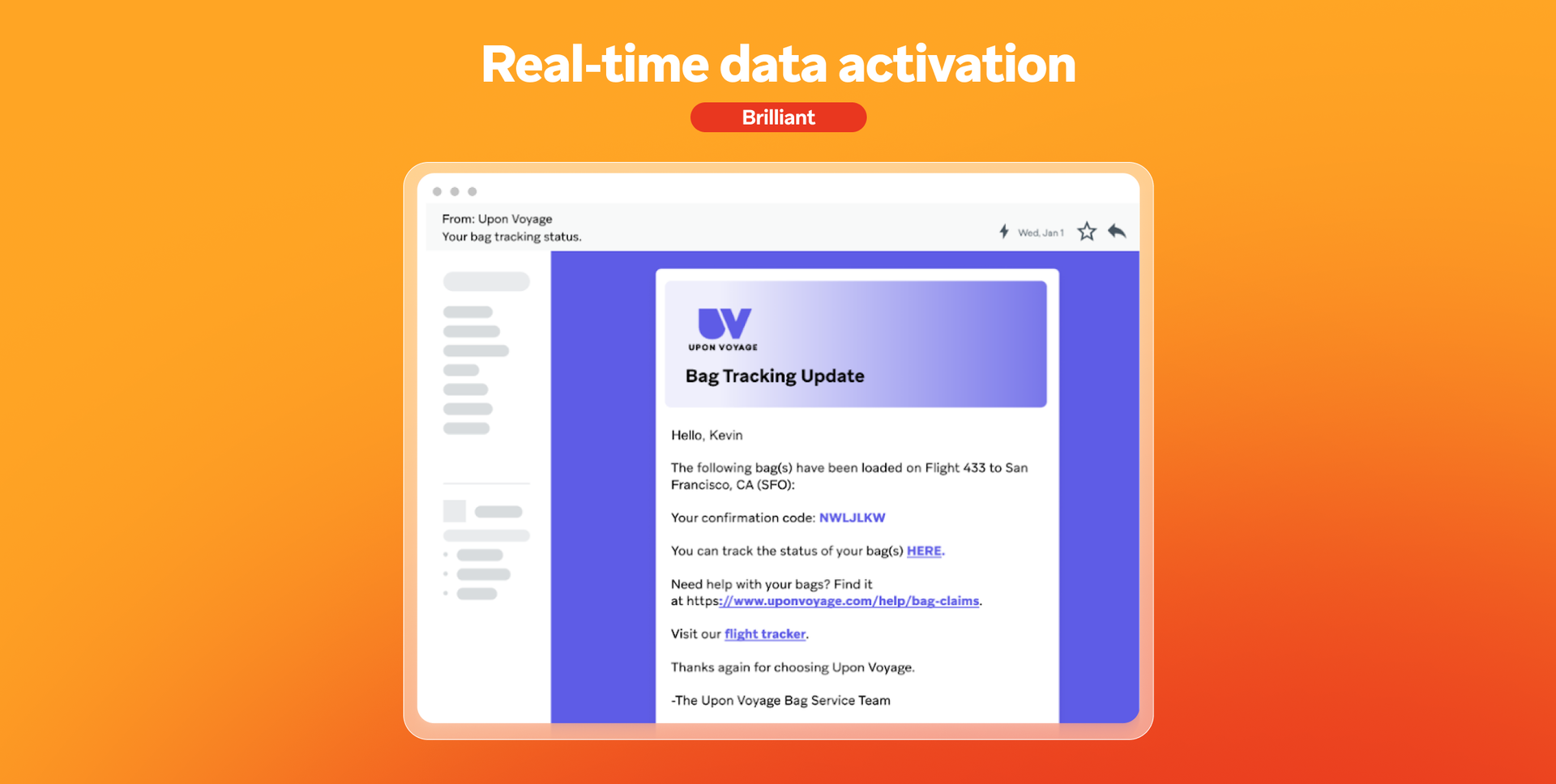
The fake brand UponVoyage gets real-time data activation right by sending a confirmation the moment a traveler’s bag successfully makes it on board their flight.
Broken email example #3: A fashion brand misses the mark with generic campaigns
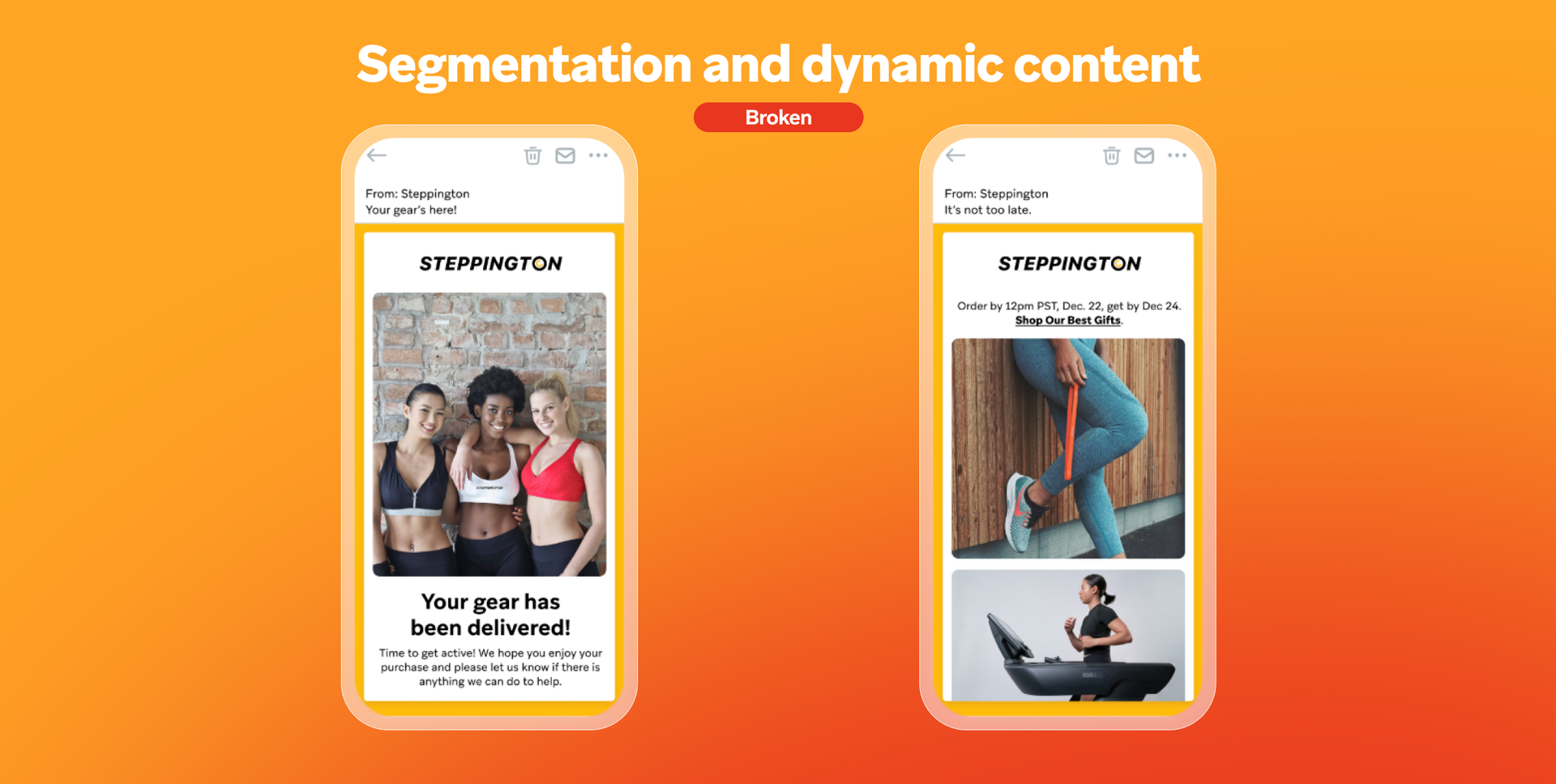
Instead of personalizing their email images based on subscribers’ demographics, this fictitious fitness company sends campaigns filled with women’s products to male recipients who’ve purchased clothing for men in the past.
Brilliant email example #3: Year-in-review campaigns
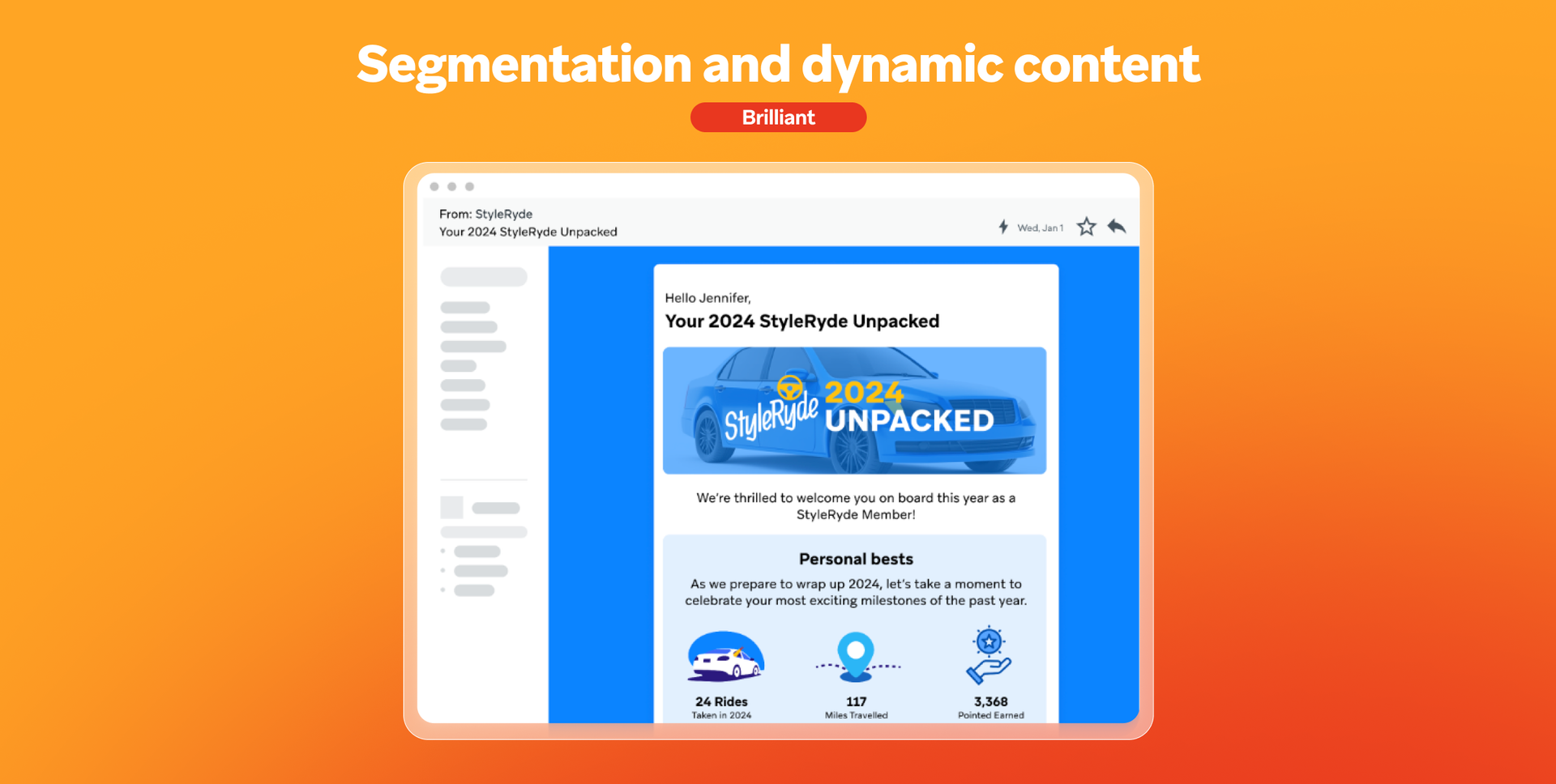
Year-in-review emails are the perfect example of marketing campaigns that truly feel like they’re offering a 1:1 personalized experience, made just for the individual.
Final thoughts
How you act on your customer data has a meaningful impact on your email subscriber experience and your brand’s overall retention. Get our guide: How Marketers Can Unlock Data and Amplify Customer Engagement to learn how you can harness your data more effectively to generate better outcomes for your brand and your customers.

